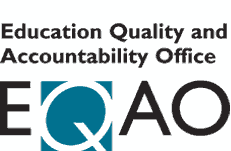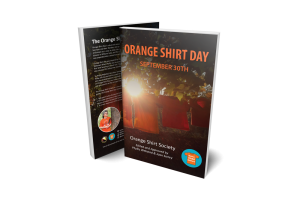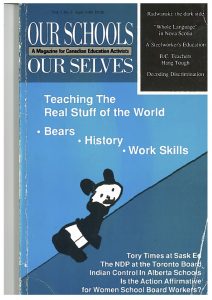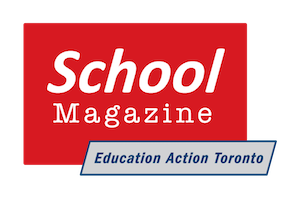OHRC’s “Right to Read”: a reader’s guide
There was a kid in my class back in the late ‘80s. Just starting grade 9, he’d come from a small town in southwest Ontario to the Trillium School, a provincial demonstration school for students with severe learning disabilities. Anyway, Jesse, as I’ll call him, was a great kid: kind, funny, circumspect, could easily make new friends at the school. He was a terrific artist, a natural – like some of the kids who just pick up reading through osmosis somehow. The first day at school went fine, but when it came around for me to do a little informal assessment to see what he knew about reading, I could see him tighten up. He didn’t even get started before a tear started to work its way down his cheek.
Reading is a human right; you can’t adequately participate in society without it – economy, social connections, political life – nothing. You can’t be critically engaged with blustering politicians like Doug Ford, the right-wingers running the so-called Freedom Convoy and so many others others like them for whom information is just something to be manipulated. Moreover, society requires good readers, who can tell the difference between supported information and rubbish. This is even clearer as people seek more information from social media, something that is sketchy-to-dangerous in what it proffers. Just a glance at the flood of misinformation surrounding the COVID-19 pandemic should be enough to make it clear that we need to be – not just so-so readers, but adept enough to be critical. Good teaching is required.
In its report “Right to Read”, the Ontario Human Rights Commission (OHRC) says the teaching of reading is suffering in Ontario. It doesn’t rely on straightforward, explicit instruction on awareness and use of sounds in words in order to read them. Schools don’t properly screen primary age students to identify those among them who have trouble with these foundational word reading skills that lead to fluent reading and comprehension of text.
This is really the impetus for the OHRC’s inquiry. It provides the context for Right to Read in that students who have trouble with the foundations of reading, early in school, don’t get better without intervention. This applies to children who might be identified as having a learning disability in the area of reading – despite otherwise average or higher abilities in thinking and reasoning. These children often have trouble identifying sounds, learning new words, reading fluently and comprehending what they read, spelling and so on. This goes for students who, for other reasons, might not learn to read easily and need timely help.
It’s important to note here, that different aspects of learning problems – oral language, reading and written language all interact: one affects and is affected by others. This picture is complicated further by the fact some kids, for any number of reasons, can pay better attention to details in language and to school in general. It’s complicated further by the myriad of self-concept issues that haunt someone, early in life, who isn’t doing as well as others at something as culturally important as school. Diagnosing specific problems in learning is a complex endeavor.
It’s much better for kids with whatever problem they have learning to read, to be discovered and understood as early as possible.
How students are doing
 Where to begin? Right to Read raises concerns about the usefulness of the Education Quality and Accountability Office (EQAO) the agency charged with measuring the success of literacy instruction in Ontario. It draws on the question raised by the International Dyslexia Association Ontario of (IDAO): “ We ask, had EQAO succeeded in its mission to provide accountability and continual improvement in literacy education would the Ontario Human Rights Commission have needed to launch the Right to Read public inquiry?”1 Questionable EQAO data about improving grade 3 and 6 reading scores over the last 15 years, IDAO says, has bolstered the notion that explicit instruction in sounding out new words isn’t necessary.
Where to begin? Right to Read raises concerns about the usefulness of the Education Quality and Accountability Office (EQAO) the agency charged with measuring the success of literacy instruction in Ontario. It draws on the question raised by the International Dyslexia Association Ontario of (IDAO): “ We ask, had EQAO succeeded in its mission to provide accountability and continual improvement in literacy education would the Ontario Human Rights Commission have needed to launch the Right to Read public inquiry?”1 Questionable EQAO data about improving grade 3 and 6 reading scores over the last 15 years, IDAO says, has bolstered the notion that explicit instruction in sounding out new words isn’t necessary.
Other tests, it claims, showed quite different results. There has been a drop, since 2000, in average reading scores for Ontario grade 4 students on the Progress in International Reading Literacy Study (PIRLS)2 For older students, it points out, there has been no increase in the Ontario Secondary School Literacy Test to coincide with improved EQAO reports and an increasing gap between high and lower scoring kids on the Programme for International Student Assessment (PISA) since 2009.3
PISA is an assessment conducted in 98 countries that measures skills of 15-year-olds in math, science and reading. Not noted, is that Canada as a whole has been above average in reading in the four assessments since 2009 and, in the 2018 assessment, Ontario was on par with the rest of Canada.4
In Ontario, 3.6 percent of 15-year-olds sampled, read below the lowest level on the assessment compared with 8 percent of kids internationally.5 They have basic reading skills as the Council of Ministers of Education Canada (CMEC) explains, to: “ locate explicitly stated information, recognize the main theme or author’s purpose in a text with a familiar topic, or make simple connections between the text and common, everyday knowledge.” 6
It’s important to note that there are inherent problems comparing large scale tests like these. Test designs differ, along with the sample size and age of the groups tested, language background and so on. Even within tests like PISA, there is considered to be an error range of 5 percent above or below the actual score reported.
Taking all of this into consideration, reading results from EQAO’s 2018-19 Provincial Elementary School report7 are still underwhelming. One quarter of grade 3 students did not meet the EQAO’s standard; for grade 6 students, one fifth of them struggled with reading. It’s worse for children from Indigenous families. Right to Read cites 2015-16 EQAO data from the Ministry document, Strengthening our Learning Journey: “ 47% of First Nations, 39% of Métis and 52% of Inuit students in the English-language system did not meet the provincial standard on the Grade 3 reading assessment…”8 The numbers aren’t much better for grade 6 students. The report notes that 21% of First Nation and 23% of Metis students in French schools didn’t meet the EQAO standard.
What is more worrisome is that that many students get help with EQAO. The IDAO reports in its 2021 study, “Lifting the Curtain on EQAO scores” a major increase over the years in use of assistive devices and/or scribing to enable some students to complete the reading assessment. In 2019, it reports 18 percent of kids who completed the grade 3 and 6 reading assessment, did so with help “to enable them to listen to the text passages and dictate their answers, this rate is six times higher than in 2005.” 9 Simply put, to complete a reading comprehension assessment, a significant number of students aren’t actually reading it.
The OHRC focused on 8 school boards across Ontario 10 and the differences in scores with and without help, are striking. For example, in the Hamilton-Wentworth DSB, 67 percent of grade 3 students met the EQAO standard. Of students identified with a learning disability, only 33 percent met the standard – if they did not get any extra help. If they did, the success rate on the reading assessment ran up to 100 percent. Similar figures hold true for students in grade 6 as well as for those in the other seven boards. So, for kids identified with a learning disability, the question is: what is the EQAO reading assessment testing?
Consequences of poor reading ability
If you have trouble with a basic skill like reading, you’re likely to be streamed into in a lower level program in secondary school. Right to Read looked at percentages of kids identified with a learning disability (LD) from the 8 school boards who end up in lower level applied courses in secondary school. At the Peel DSB for instance 44 percent of students with learning disabilities were enrolled in applied level courses compared with 28 percent who attended this level of course for other reasons.
The academic demands aren’t as high for students taking applied level courses, but the consequence is
that they often don’t meet provincial math and reading standards, don’t tend to graduate from secondary school and don’t go on to post-secondary education. As Harry Smaller writes in Restacking the Deck: Streaming by Class Race and Gender in Schools: “…why is streaming a problem at all? The answer is clear: students’ ‘life chances’ are very much determined by the kind of high school program in which they are eventually placed.”
Of course, streaming goes far beyond lack of reading ability. Class, income, race, gender, indigeneity and ethnic background determine futures for students. In their 2020 Review of the Peel DSB, Ena Chadha, Suzanne Hebert and Shawn Richard found that Black students streamed into applied courses were discouraged from going into higher level academic programmes. Indigenous young people, along with those from low income families or with English as a second language are all over-represented in streamed programs.
When these systemic problems are added to those raised by inadequate reading programs screening and

proper remediation, the inequity just gets worse. For instance, people from Black and/or Indigenous Metis, Inuit families told the OHRC inequity had a “negative or somewhat negative effect” on their school experiences with reading disabilities. Negative is too polite a word. They shared problems with others who had trouble learning to read: depression, anxiety, eating disorders, sleep loss, problems with anger. They described teasing, ostracizing, physical assault – the list is extensive – along with that grinding sense of failure you get when you just can’t seem to do, for years, what everyone around you finds relatively easy.
You avoid school, turn off. Tune out the teachers and do what you can to avoid the feeling of being stupid, lazy or, in some other way, not measuring up.
For First Nations, Indigenous and Inuit students, the report says, generational destruction stemming from colonialism – residential schools, poverty, trauma, racism, terrible housing and loss of cultural identity, to name some – exacerbate the problems in schools focused on settler culture.
The consequences of struggling with reading may be companions through life, with lower rates of graduation or financial stress on families – who could manage it – to get help for their children. And income is a major variable, since parents with higher incomes can afford to set their kids up with private tutoring (cost averaging $5 000 per year) and the all-necessary psychological assessment (cost averaging $3 000) to shorten the queue for special education support.11
These inequities multiply. Right to Read found that parents whose first language isn’t English, find it even harder to navigate the school system and get the help their children need. It’s even worse for refugee parents fleeing dreadful conditions as they try to establish themselves in a new country. Low income families may have less time to rally around their children. The same may be true for single mothers who face the additional problem of being ignored by schools.
If you live in a rural area, add travel time to fewer available supports – even if you can afford them. Franco-Ontarian families have another hurdle to jump since it’s hard to find assessments programmes and tutoring in French even though they have the same right to education services as English speakers.
And herein is a criticism of Right to Read. According to Laurentian University professor Michèle Minor-Corriveau, the French component is absent from the report. She explained the OHRC told her that it would need a whole other inquiry to cover the French language teaching, so it left that part out. English and French, she argued have different structures. Sounds in words are different and break down differently – eg “pied” “”fille” and so on. Screening tools for French students need to be normed on French-speaking populations.
Reading instruction, screening and intervention : OHRC’s main issues
Science of reading:
Right to Read argues that learning to read is a complex task. Some children grasp it quickly and easily and may well be able to pick up the skill more or less on their own. But that just isn’t the case for others. Most kids need explicit and systematic instruction on sounding out words, analyzing similarities in them and using what they learn to spell them. This is borne out by major studies including Ontario’s Early Reading Strategy, 2003 which maintains that children need to learn specifics about oral language, letters, and words and be able to connect print with the sounds and words in oral language.
It’s important to make it that the Early Reading Strategy isn’t just talking about teaching sounds of words: “Comprehensive reading instruction teaches the child to use a variety of skills to decode, read fluently, and understand the text. No single skill in this complex interaction is sufficient on its own, and the teacher must be careful not to overemphasize one skill at the expense of others.”12
OHRC argues that science does not support teaching that relies on discovery or inquiry-based learning: “Many children fail to learn to read when these approaches are used in classrooms. These are consistent with a whole language philosophy, and are used in the current Ontario Curriculum, Language, Grades 1–8, 2006 (Ontario Language curriculum) and the balanced literacy or comprehensive balanced literacy approaches practiced in Ontario school boards.”13
Balanced Literacy
Balanced literacy is pedagogy that developed in response to the Whole Language movement of the 1960s, an era when a lot of long-held theories about education were coming into question. It stresses engagement and reading for meaning, but includes explicit phonics instruction. For young teachers like myself back in 1975, the work of writers like Frank Smith and Ken Goodman was a breath of fresh air; it represented a move away from the culturally-on-another-planet basal readers towards material that reflected our students’ interests and backgrounds. Inquiry-based learning turned passive vessels into active students of a topic – engagement was the key. You can see a great example of this teaching approach in School Magazine with Elaine MacIntosh and George Martell’s article: Teaching the real stuff of the world: bears and learning together.
 It’s imperative not to lose sight of this idea of active engagement in learning. Reading well is not simply acquiring a set of skills in a systematic way. Even the small percent of students who actually do have a lot of trouble processing language, still need access to information that improves experience and vocabulary, supports better reading and is simply engaging and joyful. Right to Read doesn’t address this issue, but it mustn’t be left out.
It’s imperative not to lose sight of this idea of active engagement in learning. Reading well is not simply acquiring a set of skills in a systematic way. Even the small percent of students who actually do have a lot of trouble processing language, still need access to information that improves experience and vocabulary, supports better reading and is simply engaging and joyful. Right to Read doesn’t address this issue, but it mustn’t be left out.
The rap against Balanced Literacy according to the OHRC, is that it’s not supported by clinical studies: “balanced literacy proposes that immersing students in spoken and written language will build foundational reading skills – but significant research has not shown this to be effective for learning to read words accurately and efficiently.”14 Teachers who preferred to remain anonymous, told me of pressure to avoid structured teaching methods, sticking to inquiry-based learning. One teacher told me that it gets even harder to do this in kindergarten as class sizes have increased with full day kindergarten.
Psychologist, Linda Siegel has written extensively over many years about reading and learning disabilities and was one of two consulting psychologists who helped the OHRC develop its report. When I interviewed her for this article, she agreed that kids should be exposed to decent literature – that reading is ultimately about meaning. But she laid out her central criticism of balanced literacy: “…how are you going to know what the words say unless you can decode them?” Yes, the English language has odd words that don’t sound out easily – eg: right vs. rite- but most words are predictable and even many that aren’t – action, fiction, prediction – have enough repetition, they can be easily taught.
But is it balanced literacy or the way it’s understood that poses the real problem here? Dr. Kristy Timmons, faculty member at Queen’s University explained that there are many misconceptions when discussing a balanced literacy approach. A balanced approach is not the same as whole language teaching. The National Reading Panel (NRP) advocates for phonics instruction, though not as the dominant component in a reading program: “Finally, it is important to emphasize that systematic phonics instruction should be integrated with other reading instruction to create a balanced reading program. Phonics instruction is never a total reading program.”15 She argues it is essential to explicitly teach phonemic awareness and phonics starting in Kindergarten, but not to do so at the expense of rich language and literature.
Balanced literacy is a liberal idea that focuses on exploration, experimentation and dialogue with other students. It’s child-centred – something that has had great appeal for teachers and administrators over the last 40 years or so. But it has to be applied properly: if significant numbers of students don’t learn to read in a balanced literacy programme, something is missing. It is no longer child-centred, but class-centred. Those kids who can read, do so. Those kids who can’t do so, fall into a support system that is becoming increasingly overwhelmed by demands upon it.
Dr. Siegel notes the: “tremendous costs to society of not doing this (teaching reading) properly. I have done studies of homelessness, substance abuse, mental health issues. A lot of these are a result of someone having learning problems that aren’t being addressed in the schools. How much does it cost to keep someone in jail for a year and wouldn’t you rather spend the money on a special education teacher.”
Three Cueing Systems
Right to Read is definitely not a fan of the Three Cueing Systems. The Ministry of Education describes them in A Guide to Effective Reading Instruction – Kindergarten to Grade 3:
“Effective readers use three main cueing systems to construct meaning from print: semantic, syntactic, and graphophonic. Semantic (or meaning) cues come from a reader’s prior knowledge of reading and words, as well as from illustrations in a text. Syntactic (structural) cues come from a reader’s knowledge of language patterns and structure, especially the patterns and structure of oral language. Graphophonic (visual) cues come from a reader’s knowledge of the relationship between letters seen in print and the sounds heard in oral language.” 16
Students use semantic cues when they guess at a word they don’t know by looking at a picture in the passage they’re reading, applying their background knowledge or using the context of the story; there’s pretty good chance that background knowledge will elicit something reasonable for “The ______ jumped off the dock into the water.”
Readers use syntactic cues when they use sentence structure or their understanding of how English works, for example, to predict a tough word in “The girl was ______ down the street when she tripped on the sidewalk.” Actually, that’s an example of both semantic and syntactic cues.

Graphophonic cues involve using sound/symbol patterns, a root word or perhaps a small word within a larger one that might flip the recognition switch: t ran sit, bright ness – the list is long.
The OHRC says that the three cueing system isn’t effective because research doesn’t support it. It notes many critiques and cites an article from Reading Research Quarterly in which education researcher Tim Shanahan notes that “no research has shown that learning benefits from teaching cueing systems.”17
For sure, cueing systems alone are not an effective way to teach kids how to read words with which they struggle. But they still need something to lean on. It’s worth looking closer at some of the work noted in Right to Read. Professor Shanahan (2020) writes in the article cited above that the original research done by Ken Goodman in 1967 analyzed reading errors and concluded – without scientific evidence – that readers in general used the three cueing systems to help them read. Later studies “only found such responses when readers erred, not when reading words proficiently.”18 This raises a good question: might using strategies like these and others be useful in some cases, if not as the sole strategy for everyone?
Take, for instance a young person having a terrible time sounding out words, despite solid efforts to teach him phonics. One hypothesis: he’s having trouble holding part of a word in memory, while he tries to decode the rest of it: “slipping – s – okay I can read that, but I forget the first sound when I try to read the rest of the word ” Talk about slowing reading fluency to a crawl! Yet a simple cueing strategy like segmenting the word: “sl/ipp/ing” eases the strain on his memory while it supports phonics instruction –he repeats the sounds again and again.
The OHRC report also refers to the UK Primary Framework for Literacy and Mathematics which admonishes teachers to stick to decoding words rather than using “unreliable strategies such as looking at the illustrations, rereading the sentence, the first sound or guessing what might ‘fit’. Although these strategies might result in intelligent guesses, none of them is sufficiently reliable and they can hinder the application of phonic knowledge and skills…” 19 (my emphasis)
The Framework doesn’t provide evidence to support its claim that reading strategies hinder phonics. It also doesn’t make sense that teaching strategies to help kids unlock words more efficiently is necessarily a problem. I think it’s important to bear in mind that teachers need to be able to exercise professional judgement with their students – varied as they are in reading skills- and use strategies that work in a given situation. Right to Read is inflexible when it comes to the possibility of using other teaching methods even with phonics instruction.
Sounds, symbols and fluency
Two terms: phonemic awareness and phonics permeate the report. Phonemic awareness refers to understanding sounds and how they go together in words. At the earliest stages, a teacher would work with early kindergarten students rhyming different words out loud, breaking them down into syllables and so on: “ Rain is a pain and it’s com-ing a-gain.” The next step would include learning about sounds of words in consonant-vowel,(CV) vowel-consonant (VC)and consonant-vowel-consonant patterns(CVC)eg.- “m-a; a-m; m-a-t.” It becomes more challenging for students in grades 1 and 2 who learn to apply what they- hopefully – know to CCVC, CVCC, CCVCC words eg: “ spit, lisp, spill”
This turns into phonics instruction when a teacher refers to sounds and the symbols that go with them: what alphabetic letters go with what sounds, how to blend sounds together, gradually increasing the complexity of sounds and symbols to include blends like “cl– am, sp – am, dr– am and onto more complex phonemes like digraphs “sh, ch, th.”
All this learning needs to be reinforced with practice reading passages that focus on target sounds. Learning needs to be supported with practice in spelling similar words – generalization to other aspects of language is key.
The important matter, according to Right to Read is that this teaching is done explicitly and systematically. It is not a by-product of a story students might have been reading in class – let’s say about the Sun, where the teacher might decide to focus on “s” words. Rather, it’s stepwise, based upon “..programs that lay out the scope and sequence of phonics instruction best suited to developing readers.” 20 This kind of explicit instruction doesn’t just apply to struggling readers. As Laurentian professor Michèle Minor-Corriveau notes, while some kids learn to read regardless of the method, middle-of-the-road readers need the explicit instruction in order to focus their attention.
There’s more: practice to an automatic level – like practicing guitar chords until they become easy. This is especially important for young people having trouble blending sounds and symbols. One lesson on “can – man – fan – tan” – just won’t do. Reading needs to be practiced and it needs to be fluent for kids to be able to comprehend the text staring at them. This raises the question of texts that focus on sounds and the perennially unpopular basal readers. There are basic texts like Jolly Phonics , Dog on a Log or the Open Court Books which are the reading equivalent of practicing scales on the violin, but as Linda Siegel said “you can’t start out with Shakespeare.”
Right to Read criticizes Ontario’s Kindergarten programme for not paying enough attention to the phonemic skills needed to decode words later in school. The Ministry document is quite clear about its preference for “inquiry based learning” that focuses on children’s questions over “traditional planning” with its emphasis on topics decided by teachers and presented through standardized methods. It makes

passing reference to phonological awareness. But lack of it, according to the OHRC, particularly affects students who start school with fewer vocabulary and pre-reading skills. This criticism applies even more to that small group of kids who might have a predisposition for serious issues like learning disabilities and similar developmental variations.
Nonetheless for the education faculty members I spoke with, it’s not time to throw out levelled books and rich literature. This doesn’t get attention in Right to Read, but Professor Todd Cunningham of University of Toronto, told me that teachers “need to contextualize the systematic approach to teaching literacy.” He and his colleagues are looking at levelled reading material to see if they can repurpose them for kids to study words. Teaching phonics in isolation – is like practicing scales, but never playing songs.
Professor Jim Cummins of University of Toronto wrote in a recent critique of OHRC that the scientific community is not united in support of “stand-alone systemic” teaching of phonics:
“Unfortunately, this claim is inaccurate. There is no consensus among the research community either in North America or internationally about the appropriate way to include phonics in a comprehensive approach to reading instruction. There is consensus that the teaching of phonics—sound/symbol relationships—does have an important role in the development of decoding skills. Advocates of balanced reading instruction are very clear on this point—they do not reject the teaching of phonics or phonemic awareness. What they do reject is an approach to initial reading instruction that teaches phonics in an isolated, stand-alone, and rigid one-size-fits all manner, divorced from actual engagement with high-interest meaningful texts” 21
Early screening
It took about an hour and a half, said Dr. Linda Siegel to show teachers in North Vancouver how to administer a simple screening test to tease out problems young children might be having with words and the component sounds. Right to Read calls for the Ministry to pay for “evidence-based” screening twice a year of all children from Kindergarten to grade 2. By “evidence-based,” the report means screening tools that are standardized to measure what they claim to measure and do so consistently: if a screener is used to tease out decoding skills, the tasks it presents need to be valid and reliable.
More specifically, it recommends that students be screened at least for:
- Kindergarten – letter knowledge and phonemic awareness
- Grade1 (beginning) -phonemic awareness, identifying and sounding out words as well as reading text
- Grade 1 (second half of the year) – same as above, but with an eye on speed and accuracy of reading
- Grade 2 – timed reading for speed as well as reading passages
The point is to identify students in need of extra help, quickly, before time runs out on them and they fall seriously behind.22
 Right to Read notes that Ministry policy mandates early screening but isn’t specific about the timelines or use of evidence-based tools. The result is that school boards delay helping students with learning disabilities and similar problems. It criticizes boards it studied for not using properly developed screeners, not screening kids often enough or consistently. It doesn’t go into much more detail than that, but does raise an issue with Policy/Program Memorandum 155 (2013) that boards say has been a thorn in their side because it gives power to teachers to decide the kind and frequency of assessments they use, based on their professional judgement.
Right to Read notes that Ministry policy mandates early screening but isn’t specific about the timelines or use of evidence-based tools. The result is that school boards delay helping students with learning disabilities and similar problems. It criticizes boards it studied for not using properly developed screeners, not screening kids often enough or consistently. It doesn’t go into much more detail than that, but does raise an issue with Policy/Program Memorandum 155 (2013) that boards say has been a thorn in their side because it gives power to teachers to decide the kind and frequency of assessments they use, based on their professional judgement.
This policy grew from negotiations between Ontario and its elementary teachers who were concerned about school boards mandating broad diagnostic assessments of students. It’s going to take a lot of persuasion to introduce something as prescriptive as early screening. There are questions about the value of screening children with different linguistic backgrounds – some kids may be more aware of the sounds of their family’s language than English. With so many different languages spoken in homes across the province, phonemic awareness of English is going to vary. So, the judgment of teachers needs to be applied to interpret what the screening tools appear to tell them. Making sure that screening tools aren’t rigidly applied is an important part of this negotiation.
Reading interventions: helping students with reading difficulties
The OHRC maintains that classrooms across the province need to be better at preventing reading problems in the first place so that fewer students end up needing extra support: “many young students need interventions targeting foundational word-reading skills because classroom instruction is not based on research science.”23
It adds that school boards just aren’t providing this support and when they do, it’s often based on commercial programmes or their own ad hoc approach. At the 8 school boards the OHRC studied, about 1/3 of the commercial programmes used had undergone academic study to determine whether or not they were effective. Schools are often too late to intervene, so that kids don’t get help at the critical time they need it. Decisions about who gets reading interventions and what they will be are based on “inappropriate beliefs and unscientific criteria.”24
Teachers I interviewed on background for this article spoke emphatically about these issues. High school teachers said that there are just too many kids who can’t read or write enough to pass regular secondary level courses; they get 50 % and are passed on. One secondary teacher told me well over half of the students at his school have Individual Education Plans (IEPs) special plans often developed early in their school careers that are supposed to provide an outline for learning and accommodation. I heard of classrooms of 28 with well over a dozen IEPs. They’re meant to be short-term and effective, but too often, the plans are the response to learning problems rather than proper intervention. There are too many IEPs to monitor to see whether or not they’re working. Educators see them as a bureaucratic exercise.
Another issue is the bewildering use of integration as a strategy for helping kids. You house children with a variety of learning issues in a regular class and develop an IEP for the regular classroom teacher to follow – with maybe a bit of help from a teacher who’s taken one or more courses in special education. This is based on the prayer that all will be well if only students aren’t stigmatized by leaving the classroom for more intensive help. But as Right to Read argues, there’s not necessarily any evidence-based support programme in place. The regular classroom teacher, with no background in any of these areas might be following IEPs for a child on the autism spectrum, another with behaviour problems, several others behind in literacy skills and probably a child with an undiagnosed learning disability. Beyond the lack of “scientific criteria” for reading interventions noted in the report, teachers, again and again, are overwhelmed by the lack of any apparent plan.
But there is form if little substance. The Ministry document Learning for All – A Guide to Effective Assessment and Instruction 25 outlines how 3 tiers of intervention ought to work:
Tier 1: Most students start here. Instruction is based on the curriculum for all kids. Teachers monitor their progress, change classroom activities, groups and so on to suit different needs and note areas where some children are having trouble.
Tier 2: For kids above, who are having trouble learning in general or in a particular area like reading. Learning for All says that interventions are planned for them, instruction is further adjusted and they’re closely monitored.
Tier 3: When things have not progressed as expected in Tier 2, “even more personalized assessment and instruction are planned, often with the help of the in-school team.” The school team is usually composed of consultants in special education, the school psychologist, speech and language pathologist and social worker. More monitoring.
While this might look good, there are no specifics about what interventions entail, the sort of help students might get or how the tiers should be implemented. As Right to Read argues, interventions at any tier aren’t necessarily evidence-based. So how reliable are they?
might get or how the tiers should be implemented. As Right to Read argues, interventions at any tier aren’t necessarily evidence-based. So how reliable are they?
The report is quite specific about the characteristics of reliable interventions:
- Evidence-based methods: whether that’s classroom instruction, interventions in kindergarten or grade 1 or more help for kids in grades 2 right through high school
- Based on valid and reliable screeners to identify kids in need and provide help right away
- Early on, it needs to target foundational skills like phonemic awareness, letter/sound knowledge, accuracy and fluency of reading as well as more advanced word study.
- Clear rules:
-
- for choosing appropriate programmes for classroom use, at each tier of intervention.
- for choosing who gets help and when
- as to how educators decide what happens with each student as they pass through the tiers. What criteria are used to determine how one might get even more intensive support?
-
- Students shouldn’t have to fall behind their classmates for a certain number of years in order to qualify for appropriate help
- Monitoring progress based on valid and reliable measures.
- All students need to have access to effective reading interventions
- Rigorous methods for evaluating how well an intervention has been followed as well as its effectiveness – essentially using classroom practice as a way of studying the teaching method
- Adequate resources– teachers, materials etc. Teachers must have the professional development and coaching they need to follow through.
This section is very thorough and prescriptive – a good thing. Yet it would have been even better to see the OHRC discuss the way in which resources for students are delivered. What does it think of delivering interventions within a regular classroom? What is the roles of the resource room? What is its position on self-contained programmes for kids at the Tier 3 level? These used to consist of 8 students, a specialist teacher and a teacher’s aide. What is the Commission’s opinion on Provincial Demonstration Schools for students with severe learning disabilities? These are all central questions for dealing with the issues it raises.
What is a good reading intervention?
Here’s an example. EmpowerTM Reading was developed by Dr. Maureen Lovett at the Hospital for Sick Children in Toronto. It addresses decoding, spelling and reading comprehension for struggling readers at different age levels. For example, the Grades 2-5 Decoding and Spelling programme teaches strategies over 110 lessons, to help kids decode and spell words they can’t process. The strategies are taught in sequence and practiced on single words and in the context of passages. Accuracy and fluency, as well as rapid recognition of sound patterns, affixes and individual words are central to teaching.
Overlying teaching are metacognitive strategies that teach kids how to select, apply, monitor and evaluate the strategies they’ve learned. This is critical, because it’s not just what you know about words, but how you apply what you know and how you think about that process. This is really powerful stuff.
Since 1999, the Toronto Catholic DSB has conducted research with the Learning Disabilities Research Programme at the Hospital for Sick Children that supports long term positive results for struggling readers. Since 2009, research indicates that students at all grade levels in EmpowerTM Reading classes have made strong gains in phonemic awareness decoding, word recognition and other areas of literacy. The programme is thorough and based on evidence supported by research.
Other areas of concern
Even if schools follow OHRC’s recommendations for improving reading instruction and interventions there will still be students who need more support. It underscores the responsibility of schools to accommodate students, through assistive technologies like tablets, software for reading and for translating speech to text, along with extra time for tests and assignments and adjusted evaluation criteria. It advocates for kids who face barriers to accommodations in school such as concomitant issues of race, class or a coexisting disability and lack of training or support from educators all through the system.
What about further assessment of children who aren’t responding to extra help? Right to Read says that if a child isn’t responding to interventions by grade 1 or 2, they should be referred for a psychoeducational assessment rather than waiting until grade 3 as is common practice currently. It argues that the focus of such an assessment be on reading, writing and math since these are connected. Unfortunately, it doesn’t call for assessments to necessarily consider other interactive areas of functioning like different forms of attention and oral language.
Of the school boards the OHRC studied, it found that referrals for assessment were a mish-mash. Most boards made efforts to have psychologists and professionals like speech and language pathologists meet with local school staff to go over strategies to assist kids. But referrals for assessments varied because schools wouldn’t necessarily follow the same criteria for who might qualify. Cultural or other forms of bias played a role here. The Commission found limits to the number of assessments per school that could be made. Wait times for assessments could be very long; tracking or managing wait lists was inconsistent. 26
One of its recommendations is to remove references to average intellectual ability from the criteria for identifying kids with a reading disability or dyslexia. This is beyond the scope of this article, but certainly begs further discussion.27
Right to Read also calls on the school system to identify the type of learning disability affecting a student, such as in the area of reading, written language or math. It also wants to see the term “dyslexia” which refers specifically to reading, come back into general use. 28
Overall, the OHRC argues that Ontario’s school system is too decentralized with little guidance from the Ministry to set consistent standards to screen young children, intervene with problems, accommodate needs and assess results. It doesn’t mandate clear learning expectations for reading in early grades. Data collection on waiting lists and efficacy of interventions varies considerably. Plans to improve reading need better monitoring and organization. Right to Read calls for province-wide action to “protect the rights of students with reading disabilities.” The list is very specific and includes:
- Implementing OHRC’s recommendations
- Offering the same high level of special education programming wherever students live in the province or within their boards
- Details from school boards outlining progress on implementing evidence-based instruction for word reading and screening, tools and programmes to be used as well as methods for assessing their success. Boards should provide information about what interventions are being used and criteria for determining efficacy along with detail about accommodations and modifications to programmes.
- Board reports on criteria for referring students for psychoeducational assessments, management of wait lists as well as average wait times. The Ministry should review all special education plans and ensure they are implemented.
- The Ministry ensuring that special education funding is actually used for this purpose, including money meant for students with reading disabilities. It should check that boards don’t spend money on supports or program that are not evidence- based
- Common, centralized data management systems to keep track of students with disabilities – particularly with a reading disability or dyslexia. This data should include information about interventions and their results. It should also include “equity indicators “ like race, ethnicity, religion, disability, gender identity, sexual orientation and socioeconomic status. All of this needs to be uploaded to the Ministry for “further analysis”29
- School boards, schools and educators providing information, in languages appropriate to their communities, about screening, interventions, accommodations and assessments for students with reading problems – timing, monitoring and reporting on progress, how parents can request services and advocacy groups that will help them
- Individual Education Plans (IEPs) written in plain language, with consultation from parents and- I’d add- students. School boards to encourage parents to be central to the decision-making process about their children by connecting them with advocacy groups that offer support for students with reading problems. 30
 The recommendations of OHRC in this section about accommodations, assessments and systemic issues mostly make sense and represent good teaching, assessment and management methods that have been around, albeit inconsistently, for decades. Certainly, the OHRC has done its job to bring light to the issues kids face if they have trouble learning to read, and the best ways to help them and their families.
The recommendations of OHRC in this section about accommodations, assessments and systemic issues mostly make sense and represent good teaching, assessment and management methods that have been around, albeit inconsistently, for decades. Certainly, the OHRC has done its job to bring light to the issues kids face if they have trouble learning to read, and the best ways to help them and their families.
However, it advocates even more Ministry oversight and bureaucracy to ensure that the details within its 157 recommendations are implemented. I understand it has to do this in order to be thorough, but it beggars belief if it thinks the Ministry of Education is going to improve the situation. In that way, the report misses the political context. This is a Ministry which has not been able to come up with a reasonable funding formula for school boards facing a $16.3 billion deficit in school repair. It is a Ministry which cuts funds to school boards forcing them to decide whether or not to hang onto music programmes or outdoor education classes. Far from promoting individualized attention for students, it mandates 2 online courses and pushes to increase class sizes. Far from supporting school boards throughout COVID, this Ministry “allows” boards to take funds from their reserves to pay for extra costs. As the Right to Read report, itself, makes clear, this is a Ministry that is deeply confused about what the bottom line is for learning how to read in Ontario – whether it’s the primacy of inquiry-based education over skills or maybe a bit of both.
There’s also the broader context of other young people with special needs. School Magazine recently published an article by Karen Bojti, parent of an autistic son, in which she details the relentless struggle of parents defending their children as Ontario maintains a waiting list of 53 000 young people needing proper services to take part in society. I wish that the OHRC had, at least, noted this bigger problem. I wish that it had included the many other groups of children who need help in its recommendations. Not doing so, narrows the advocacy of the OHRC, though I’m sure that wasn’t its intention.
The most valuable contribution in Right to Read is its appeal for kids be taught to read in a specific way – based in phonics – which can be monitored and altered if the plan isn’t working. As long as instruction is carried out in the context of engaging literature, this is the core of good teaching. There is no room for fuzzy thinking like “wait and see;” the costs are too high. No one is going to suffer from phonemic awareness or practice in applying sounds to reading and spelling. It’s not going to hurt young students if their teachers are more aware – right away – which of them needs help. It’s only going to help students with reading disabilities, if their schools and boards provide them with evidence-base programmes, accommodations and reasonable plans for which someone is accountable. The OHRC is fundamentally calling for rigour in teaching reading. I disagree with some of the details of the report, but keep coming back to that point.
References:
- Lifting the Curtain on EQAO Scores – International Dyslexia Association of Ontario, September 2021 p. 3
- Ibid p.10
- Ibid p. 11
- Measuring up: Canadian Results of the OECD OISA 2018 Study- Council of Ministers of Education Canada (CMEC), 2019 p. 11
- Ibid p. 84
- p.12
- Ontario Student Achievement: EQAO’s Provincial Elementary School Report: Results of the Assessments of Reading, Writing and Mathematics, Primary Division, 2018–2019 – Education Quality and Accountability Office, 2019 p.12
- OHRC Right to Read Inquiry Ch 7 – also note Strengthening Our Learning: Technical Appendix Third Report pp 9 & 18
- Lifting the Curtain on EQAO Scores – International Dyslexia Association of Ontario, September 2021 p.2
- District School Boards reviewed by OHRC: Hamilton-Wentworth; Keewatin-Patricia; Lakehead; London Catholic; Ottawa Carlton; Peel; Simcoe Muskoka Catholic; Thames Valley
- Right to Read Ch 6 – Financial Impact
- Early Reading Strategy: The report of the Expert Panel on Early Reading, Ontario, 2003 p.22
- Right to Read Ch 8 – Introduction
- Ibid
- Report of the National Reading Panel: Teaching children to read : An evidence-based assessment of the scientific research literature on reading and its implications for reading instruction National Reading Panel & National Institute of Child Health and Human Development, 2000 pp 2-97
- A guide to Effective Reading Instruction Kindergarten to Grade 349
- Right to Read Chapter 8 – Cueing Systems
- What Constitutes a Science of Reading Instruction? -T Shanahan, Reading Research Quarterly, 55 -2020 p.239
- Phonics and early reading: an overview for headteachers, literacy leaders and teachers in schools, and managers and practitioners in Early Years setting Primary Framework for Literacy and Mathematic, UK, 2006 p.9
- Right to Read Ch 8: Applying best practices for reading instruction and foundational skills
- Ontario Human Rights Commission ‘Right to Read’ Report: Sincere, Passionate, Flawed – J Cummins, University of Toronto, March 2022, ( manuscript provided to School Magazine)
- Early Intervention for Children at Risk for Reading Disabilities: The Impact of Grade at Intervention and Individual Differences on Intervention Outcomes- M Lovett et al, Journal of Educational Psychology, Vol 109 (7), Oct 2017, pp.889-914
- Right to Read Ch. 10 – Reading Interventions
- Ibid
- Learning for All – A Guide to Effective Assessment and Instruction, Ministry of Education Ontario, 2013 p.24
- Right to Read Ch. 12 – School board approaches to professional assessments.
- Ibid – Recommendation 111
- Ibid – Recommendation 114
- Right to Read Ch. 13 – Recommendations 142-144
- Ibid – Recommendations 253-155

